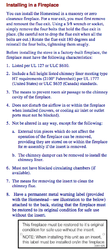- Jul 19, 2007
- 5
We have a 20 year old Superior FR3870 zc fireplace that we have not used in the 6 years we have been in the house. It appears to be in good shape.
Now my wife and I are wanting a freestanding wood burning stove for the hearth.
Idea is to set up like the Regency H2100 "hearth heater", namely observe clearances for combustibles from the back of the stove, and go into the zc fireplace with horizontal connector, then up with 6" ss liner. Want to cover the face with a tiled backerboard.
Max height above the hearth for the top of the flue collar is 26 inches. There is a 2x4 header across the top of the zc fireplace, which could be replaced with steel, if necessary.
I have mixed signals from installers/sweeps on this installation. Hearth.com has a sort of general statement, but ends with "contact a licensed installer" or something similar. Any suggestions? Dangerous or no?
Thanks.
Now my wife and I are wanting a freestanding wood burning stove for the hearth.
Idea is to set up like the Regency H2100 "hearth heater", namely observe clearances for combustibles from the back of the stove, and go into the zc fireplace with horizontal connector, then up with 6" ss liner. Want to cover the face with a tiled backerboard.
Max height above the hearth for the top of the flue collar is 26 inches. There is a 2x4 header across the top of the zc fireplace, which could be replaced with steel, if necessary.
I have mixed signals from installers/sweeps on this installation. Hearth.com has a sort of general statement, but ends with "contact a licensed installer" or something similar. Any suggestions? Dangerous or no?
Thanks.



